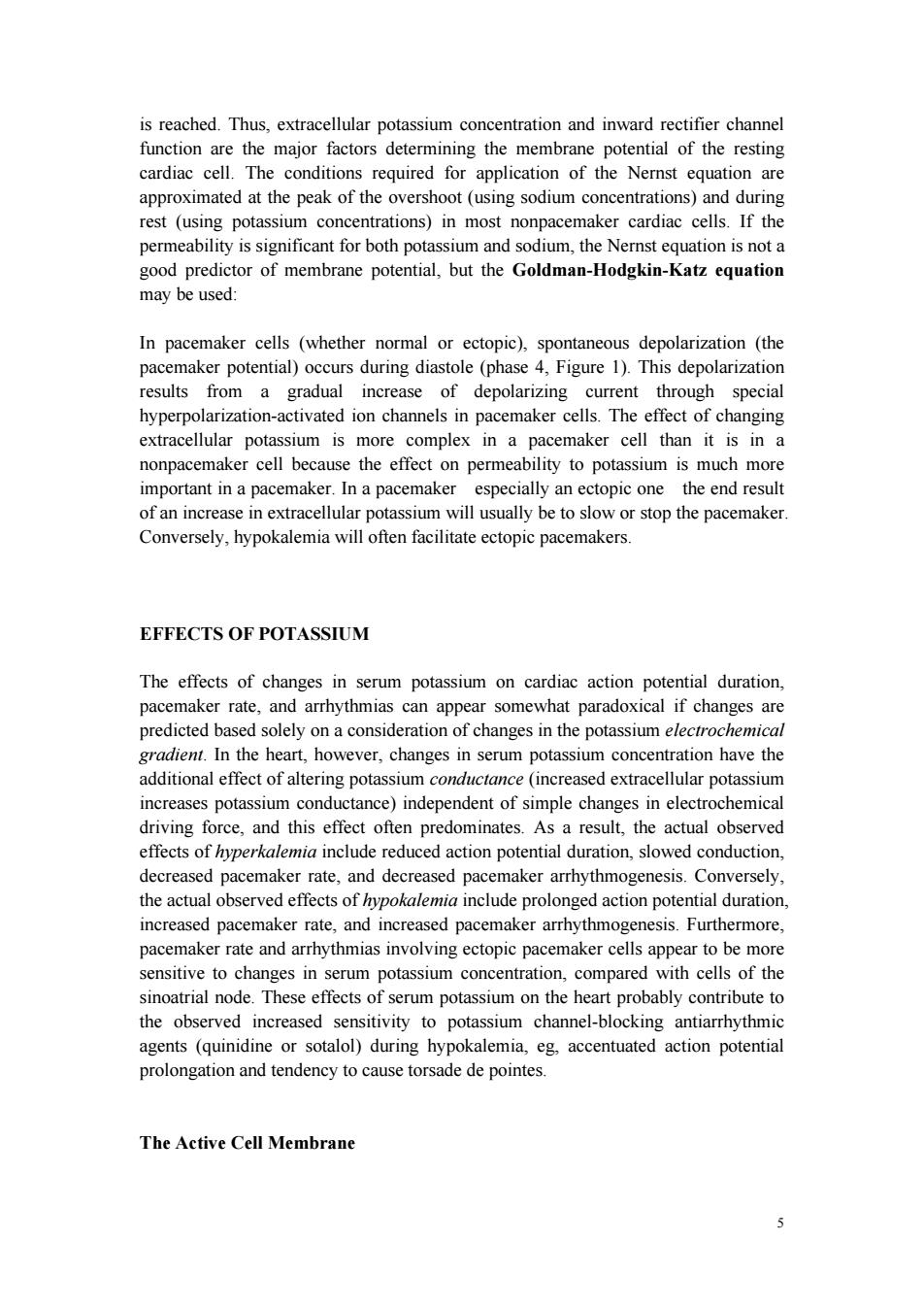正在加载图片...

is reached.Thus,extracellular potassium concentration and inward rectifier channel function are the major factors determining the membrane potential of the resting cardiac cell.The conditions required for application of the Nernst equation are approximated at the peak of the overshoot (using sodium concentrations)and during rest (using potassium concentrations)in most nonpacemaker cardiac cells.If the permeability is significant for both potassium and sodium,the Nernst equation is not a good predictor of membrane potential,but the Goldman-Hodgkin-Katz equation may be used: In pacemaker cells (whether normal or ectopic),spontaneous depolarization (the pacemaker potential)occurs during diastole (phase 4,Figure 1).This depolarization results from a gradual increase of depolarizing current through special hyperpolarization-activated ion channels in pacemaker cells.The effect of changing extracellular potassium is more complex in a pacemaker cell than it is in a nonpacemaker cell because the effect on permeability to potassium is much more important in a pacemaker.In a pacemaker especially an ectopic one the end result of an increase in extracellular potassium will usually be to slow or stop the pacemaker. Conversely,hypokalemia will often facilitate ectopic pacemakers. EFFECTS OF POTASSIUM The effects of changes in serum potassium on cardiac action potential duration, pacemaker rate,and arrhythmias can appear somewhat paradoxical if changes are predicted based solely on a consideration of changes in the potassium electrochemical gradient.In the heart,however,changes in serum potassium concentration have the additional effect of altering potassium conductance (increased extracellular potassium increases potassium conductance)independent of simple changes in electrochemical driving force,and this effect often predominates.As a result,the actual observed effects of hyperkalemia include reduced action potential duration,slowed conduction, decreased pacemaker rate,and decreased pacemaker arrhythmogenesis.Conversely, the actual observed effects of hypokalemia include prolonged action potential duration, increased pacemaker rate,and increased pacemaker arrhythmogenesis.Furthermore, pacemaker rate and arrhythmias involving ectopic pacemaker cells appear to be more sensitive to changes in serum potassium concentration,compared with cells of the sinoatrial node.These effects of serum potassium on the heart probably contribute to the observed increased sensitivity to potassium channel-blocking antiarrhythmic agents (quinidine or sotalol)during hypokalemia,eg,accentuated action potential prolongation and tendency to cause torsade de pointes. The Active Cell Membrane 55 is reached. Thus, extracellular potassium concentration and inward rectifier channel function are the major factors determining the membrane potential of the resting cardiac cell. The conditions required for application of the Nernst equation are approximated at the peak of the overshoot (using sodium concentrations) and during rest (using potassium concentrations) in most nonpacemaker cardiac cells. If the permeability is significant for both potassium and sodium, the Nernst equation is not a good predictor of membrane potential, but the Goldman-Hodgkin-Katz equation may be used: In pacemaker cells (whether normal or ectopic), spontaneous depolarization (the pacemaker potential) occurs during diastole (phase 4, Figure 1). This depolarization results from a gradual increase of depolarizing current through special hyperpolarization-activated ion channels in pacemaker cells. The effect of changing extracellular potassium is more complex in a pacemaker cell than it is in a nonpacemaker cell because the effect on permeability to potassium is much more important in a pacemaker. In a pacemaker especially an ectopic one the end result of an increase in extracellular potassium will usually be to slow or stop the pacemaker. Conversely, hypokalemia will often facilitate ectopic pacemakers. EFFECTS OF POTASSIUM The effects of changes in serum potassium on cardiac action potential duration, pacemaker rate, and arrhythmias can appear somewhat paradoxical if changes are predicted based solely on a consideration of changes in the potassium electrochemical gradient. In the heart, however, changes in serum potassium concentration have the additional effect of altering potassium conductance (increased extracellular potassium increases potassium conductance) independent of simple changes in electrochemical driving force, and this effect often predominates. As a result, the actual observed effects of hyperkalemia include reduced action potential duration, slowed conduction, decreased pacemaker rate, and decreased pacemaker arrhythmogenesis. Conversely, the actual observed effects of hypokalemia include prolonged action potential duration, increased pacemaker rate, and increased pacemaker arrhythmogenesis. Furthermore, pacemaker rate and arrhythmias involving ectopic pacemaker cells appear to be more sensitive to changes in serum potassium concentration, compared with cells of the sinoatrial node. These effects of serum potassium on the heart probably contribute to the observed increased sensitivity to potassium channel-blocking antiarrhythmic agents (quinidine or sotalol) during hypokalemia, eg, accentuated action potential prolongation and tendency to cause torsade de pointes. The Active Cell Membrane